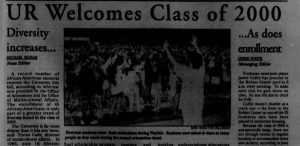By Maryam Tahseen
“UR Welcomes Class of 2000 – Diversity Increases” stated the front page article of the 5th September 1996 issue of the Collegian. This article discussed the great strides our university admissions department made in accepting a diverse student body, specifically African American students. From what one could gauge from this article, it seemed that campus diversity and minority student representation was increasing at the university.

However, hidden on page five of another Collegian article in the same year was an incident of racism faced by two black student athletes. On their first day at the university campus, they were called “blackies” by white students. In another article from the 6th February, 1997 issue, students struggled to get attendance at events organized for the Black History Month because of the strained relations between the black and white students on campus. In the Collegian issue of 6th March, 1997, a number of the black students on campus complained that the university had misrepresented the diversity on campus. They stated that the admissions brochures sent to them by the university were “misleading, even deceptive” because photographs in the brochure featured at least one student of color 43% of the time, non-white students only made up 11% of the student body. However, the admissions staff maintained their stance that the brochures represented diversity of thought and not just diversity of skin color.
Our university has a history of whitewashing student concerns, specifically when it comes to minority students. Our university administration failed to take a concrete measure against the playing of the Dixie from 1971-1975 when black students protested to the playing of the song. Similarly, the university barely made an effort to help integrate black students into the university until the students took matters into their own hand by creating Students Organizing for Black Awareness (SOBA), an organization for black students in early 1970s. Therefore, it came as no surprise that our university claimed a substantially diverse student body in 1996 while the Princeton Review ranked us 12th in the top 20 schools with the most homogeneous student population. In the same year, we were ranked 15th in the strained race and class relations category of the Princeton Review. No specific reason was given for the strained race relations at the university but based on the views of Christian Pedersen, a junior at the university who interviewed for the Collegian in the Oct 24th, 1996 issue, it could have been because of the high cost of attending the university. According to him, the university attracted students from a similar socio-economic background which made it harder for minority students from different backgrounds to adjust to the university.
It is surprising and astonishing that almost two decades later, minority students on our campus still continue to grapple with adjustment issues. Although our university has taken initiatives such as organizing the Black History Month and Women of Color Conference, a lot needs to be done on behalf of the university administration to ensure that black students on campus feel involved and part of the community.
Maryam Tahseen is a junior majoring in Accounting with a concentration in Finance and minoring in Women, Gender, and Sexuality Studies. She is from Islamabad, Pakistan. As an international student, she is very excited to uncover the lives of international students along with underrepresented minorities through the Race & Racism Project.
